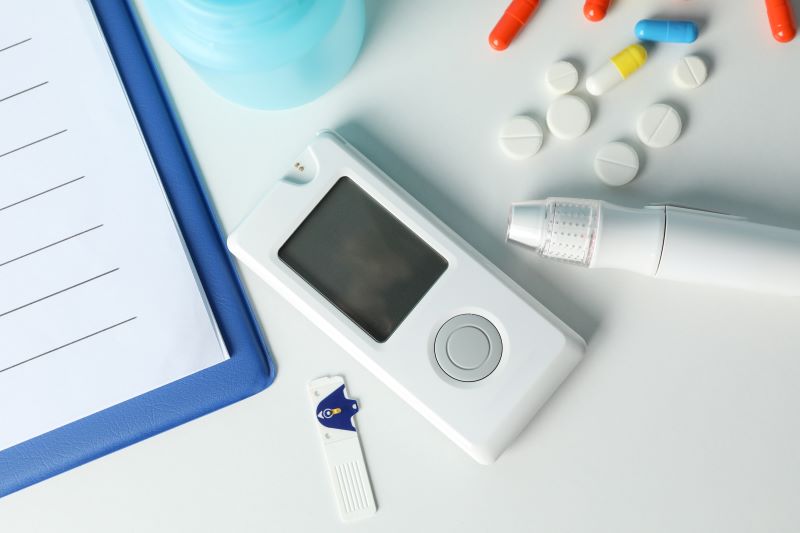For the best health throughout your life and body changes, it’s worth knowing more about common diseases and their effects on your body. Knowing more about common diseases, their effects on your body, the treatment and prevention of serious diseases, and their potentially serious side effects when not responsibly cared for all go a long way toward increasing your good health, decreasing financial impacts from medical procedures and care, and your overall quality of life. In this article, we’ll discuss how diabetes affects your foot, including what diabetic foot and white toes are, and how neuropathy socks may work for you.
 How Does Diabetes Work?
How Does Diabetes Work?
Diabetes is a highly common disease that affects over 37 million Americans each year, about 90-95% of whom have type 2 diabetes. Type 1 diabetes can happen at any age but is much less common than type 2, only affecting only around 5-10% of diabetics. With type 1 diabetes, the pancreas creates little to no insulin. Insulin is important for helping your blood sugar enter your body’s cells, which your body then uses for valuable energy. Without insulin, blood sugar is unable to enter the cells and starts to increasingly build up. High blood sugar can be very harmful and causes several of the most common symptoms and complications of diabetes.
Type 2 diabetes is most common in people aged 45 or older. However, this type is also growing consistently in commonality for children, teens, and young adults each year. Cells don’t react to insulin in a normal way with type 2 diabetes. Many refer to this occurrence as insulin resistance. Consequently, the pancreas creates increased amounts of insulin in an attempt to get the cells to react properly. Eventually, the pancreas is unable to keep pace, and blood sugar levels rise, which can result in either prediabetes or type 2 diabetes. High blood sugar can cause serious health conditions such as heart disease, kidney disease, and vision loss.
 How Does Diabetes Affect Feet?
How Does Diabetes Affect Feet?
Just as diabetes is common and growing in prevalence throughout the US, foot problems and complications are common for people with diabetes. While there are some serious risks to your feet and other body parts due to diabetes, including issues and loss in the toes, feet, and legs, you can effectively lower the risks of having diabetes-related foot problems through regular foot care and maintenance. Managing blood sugar or glucose levels also goes far toward keeping your feet healthy. Diabetes can cause nerve damage, more injuries and infection, lower blood flow, bone shifts and breaks, other serious conditions, and in extreme cases, body parts losses.
Nerve Damage
Over time, diabetes can result in diabetic neuropathy, which is nerve damage that can cause feet to have pain, tingling, and a loss of feeling.
Injuries and Infection
When you lose the feeling in your feet, you are less able to feel a blister on your feet or a pebble in your sock, which can also lead to cuts and sores that can experience infection.
Lower Blood Flow
Diabetes can also dramatically lower blood flow throughout your feet, which can make it more challenging for an infection or a sore to quickly and properly heal, or not heal at all.
Shifts and Breaks
In some cases, the nerve damage from diabetes can result in shape changes in your feet, such as Charcot’s foot, which starts with redness and swelling and ends in bone shifts and breaks.
Serious Conditions
Untreated infections or infections that don’t heal can lead to gangrene, (a serious or even fatal condition resulting from less blood flow), or foot ulcers, which affect around 15% of diabetics.
Body Parts Losses
Foot ulcers and gangrene that don’t improve or heal can lead to a possible need for amputation of the afflicted toes, feet, or part of the legs to prevent the infection from spreading.
What Is Diabetic Foot?
Foot problems are highly common for people with diabetes, occurring over time as high blood pressure potentially damages the blood vessels and nerves of the feet. This diabetic neuropathy is what causes what is referred to as diabetic foot, including tingling, numbness, pain, or loss of feeling in the feet.
Two of the most common foot conditions that affect people with diabetes are neuropathy and poor circulation. A diabetic foot exam helps to effectively evaluate the potential for injury, infection, and bone abnormalities. At least one foot exam per year is the suggested number for regular diabetic patients, and increased frequency per year if conditions worsen or if you experience numbness, tingling, pain, swelling, difficulty when walking, or a burning sensation.
What are White Toes?
White toes occur when blood vessels suddenly become narrow and less able to properly carry blood, turning toes a white color from a lack of blood. Many refer to this painful condition as Raynaud’s disease and it’s more common in women than men. Blood flow issues causing white toes may require surgery as a last resort option, decided on after speaking with a foot and ankle specialist to determine when or if surgery is necessary to treat your given condition.
How Do Neuropathy Socks Work?
For diabetics experiencing diabetic neuropathy, neuropathy socks are another effective treatment option before you consider more invasive procedures. Many report significant relief from the “pins and needles” painful feeling when wearing neuropathy socks. These are diabetic socks made without seams along the toe line to reduce the risks of rubbing and blisters, improve circulation, and help heal otherwise dangerous injuries. Good neuropathy socks and foot health aids protect from bacteria and harmful moisture, are an ideal fit to avoid rubbing or exposure and may have extra heel and toe padding.
 The Right Diabetes Care and Prevention for You
The Right Diabetes Care and Prevention for You
The Foot & Ankle Specialists of Illinois are ready to provide the right diabetes care and prevention for your legs, feet, and toes. People in Algonquin, Elgin, and Huntley come to see us for all of their diabetic foot needs. Experience the management and pain relief toward various diabetic-related ankle and foot conditions with numerous offered services today.

